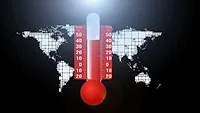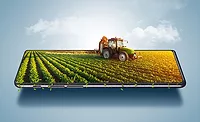Climate Change and Emerging Risks to Food Safety: Building Climate Resilience

Video credit: jitendrajadhav/Creatas Video via Getty Images
Climate change and variability influence the occurrence of microbiological pathogens (bacteria, parasites, fungi, and viruses), and pests and invasive species that are harmful to animal and plant health. For example, infections with Salmonella and Campylobacter are positively correlated with warmer temperatures.2 The risk of campylobacteriosis could rise in regions with projected increases in precipitation or extreme flooding.7 Furthermore, coastal areas experiencing warming, changes in precipitation, and changes in nutrient inputs can experience increasing prevalence and expansion of Vibrio bacteria, increasing the risk of human infection.3 Cholera outbreaks have occurred in different regions after natural disasters, including a three-fold increase in cholera outbreaks in African El Niño-sensitive regions.3 Increased norovirus risk in marine water and in shellfish are linked to extreme events, floods, and temperature changes.
Adaptation to emerging microbiological food safety risks has focused on targeted risk management options with high potential for preventing or reducing specific microbiological risks:
- Vaccination of poultry for salmonellosis and campylobacteriosis
- Real-time, remote sea surface temperature and salinity monitoring for the prediction of environmental suitability of pathogenic Vibrio
- Improved disease surveillance for Vibrio spp. and monitoring of recreational water, alerts, and beach closures
- Prevention of norovirus outbreaks through sanitary conditions for shellfish cultivation and handling including harvest area surveys, water quality monitoring, preharvest viral dilution, and by alerts to local fisheries, retailers, restaurants, and consumers (Table 1).
Addressing Climate-Related Chemical Risks to Food Safety
Climate-related extreme events, floods, and droughts interact with environmental chemical contaminants, influencing transport pathways and leading to changes in chemical contamination of soil, water, and food, as described below.
Mycotoxins. Climate change and extreme events affect the growth and geographical expansion of toxigenic fungi in crops, resulting in the contamination of foods and feeds with mycotoxins and increasing the risks to humans and animals. The occurrence of toxin-producing fungal phytopathogens is likely to increase and expand from tropical and subtropical regions into new areas.
Climate change has altered the migration of major mycotoxins (deoxynivalenol, ochratoxin A, aflatoxin, fumonisin, and zearalenone) into new areas in Africa that lack the capacity for risk management, monitoring, and surveillance. Aflatoxin contamination risk in maize is predicted to increase in a +2 °C temperature scenario in Europe; and in Kenya, for every increase of 2 °C average daily temperature the likelihood of aflatoxin increases by 57 percent.8
Harmful Algal Blooms (HABs).The occurrence of HABs and risk of seafood contamination with marine toxins are increasing due to warming of ocean surface waters at the global level. Changes are seen in the occurrence, intensity, species composition, and toxicity of marine and freshwater algae and bacteria. Ciguatera in fish has spread from the Caribbean to the Canary Islands and Madeira, and is expanding into the Southern Hemisphere. Climate-induced changes to freshwaters and the ocean favor the proliferation of harmful cyanobacteria and algae, and under future global warming scenarios, an increase in the exposure of humans and farmed animals to cyanotoxins is expected.
Methylmercury (MeHg) Bioaccumulation and Biomagnification. Increasing temperatures in northern regions are causing permafrost to thaw, releasing mercury from snow and ice into aquatic ecosystems. Mercury methylation in aquatic environments is facilitated by ocean warming. The uptake of methylmercury (MeHg) in fish and mammals increases by 3–5 percent for each 1 °C rise in water temperature.9
MeHg is highly neurotoxic and nephrotoxic, and it bioaccumulates and biomagnifies throughout the food web via dietary uptake (fish, seafood, and mammals).10 Consumption of fish contaminated with MeHg is a major public health risk, leading to severe neurological toxicity and impacting children's cognitive capacity (i.e., Minamata disease).
Looking for quick answers on food safety topics?
Try Ask FSM, our new smart AI search tool.
Ask FSM →
Persistent Organic Pollutants (POPs).Global warming is melting snow and ice caps, leading to the release of POPs and MeHg from land-based sources into coastal ecosystems.11 Exposure to POPs can lead to health effects including cancer, birth defects, and impairments to the immune, reproductive, and neurological systems. Climate–contaminant interactions alter the bioaccumulation and biomagnification of POPs, PCBs, and MeHg throughout the food web and increase the risk of human exposure through diet. This is particularly concerning for indigenous communities in the Arctic, where traditional foods have been long-term contaminated with POPs and MeHg, posing public health risks.
Pesticides and Veterinary Residues and Increasing Resistance. Climate change drives the introduction and spread of pests and diseases affecting plant and animal health, triggering increased use of pesticides. This leads to pesticide resistance and to the presence of residues in foods.2,13 Emerging zoonoses and changes in the distribution, survival, and transmission of vectors and pathogens can lead to an increased use of antimicrobials in animal farming and in aquaculture,2,13 leading to the presence of antimicrobial residues in foods and contributing to antimicrobial resistance. Warming temperatures facilitate the horizontal transfer of resistance genes. Extreme weather events increase the likelihood of floods in areas with waste from animal farms where antibiotics are used, facilitating the spread of antibiotic-resistant bacteria into the environment.13
Adaptation to emerging chemical food safety risks includes targeted risk management options with high potential for reducing specific food safety chemical risks. The prevention of seafood contamination with marine toxins requires the establishment of HABs monitoring and early warning systems, requiring access to data on sea surface temperature and salinity. The establishment of regulatory frameworks to prevent seafood contamination with marine toxins is supported by community education on HABs. Prevention of mycotoxins requires regulations for preharvest and postharvest controls, guidelines and capacity-building for appropriate storage and silage, and improved monitoring systems to reduce mycotoxin entry into the food chain.
To prevent the risks of food contamination with heavy metals and POPs, there is a need for regulations on MeHg and POPs concentration in seafood. Phasing out the use of POPs and Hg are critical. Regulatory frameworks must include the establishment of maximum residue limits for pesticides and veterinary drugs. Other strategies include the adoption of integrated pest management, biocontrol, organic production, and effective crop-specific pest management strategies. Regional and local dietary guidelines should restrict contaminated food intake and increase dietary diversity, particularly for children and pregnant persons, to potentially prevent some emerging chemical risks in foods (Table 2).
Climate Action and Emerging Food Safety Risks
Climate change adaptation and mitigation actions may bring new food safety risks associated with the introduction of novel food and feed sources of protein, new technologies, and new production systems, such as sustainable intensification, circular bioeconomy, and water and food waste reuse, among others.
Emerging sources of alternative foods and feed protein are increasingly used to reduce the impacts to climate change attributable to conventional food production.14 Plant-based alternatives, cell-based meat, insects, algae, and jellyfish are proposed as alternative sources of protein in foods. Emerging sources of protein require safety assessments, in particular the assessment of the potential allergenicity of new or modified proteins.
Plant-based alternatives to meat are expanding in view of change in consumption patterns. Vegetarian/vegan consumption patterns and the global sales of associated products are expected to surge. Chemical hazards such as mycotoxins that are present in food ingredients (e.g., cereals, soy, nuts), or arsenic in rice, can end up in the final food products, such as plant-based beverages.
Seaweed consumption is spreading beyond Asia, and it is expected to continue growing, in part because of its nutritional value and sustainability (seaweeds do not need fertilizers to grow, and they help combat ocean acidification). A key concern is their ability to accumulate high levels of heavy metals like arsenic, lead, cadmium, and mercury.
Insects are a source of protein, fiber, fatty acids, and micronutrients like iron, zinc, manganese, and magnesium. However, insects can have foodborne contaminants and can provoke allergic reactions in some people, particularly those with shellfish allergies or sensitivities. Meanwhile, sources of cell lines, growth media components, and potential for microbiological contamination are some of the major food safety considerations for cell-based foods.
Sustainable Intensification Production Systems. Sustainable intensification has been proposed as a response to the challenges of climate change and food insecurity and to meet increasing food demand within planetary boundaries (i.e., producing more by using less land and fewer inputs). Intensification can lead to increased or new uses of agrochemicals such as fertilizers (aiming to increase yields), pesticides for plant health management, and antimicrobials to prevent animal diseases, which can negatively impact food safety and human health.
Controlled environment agriculture systems, such as vertical farming or hydroponics (including closed aquaculture), extend growing seasons and conserve water; however, they carry the risk of spreading pathogens and contaminants into closed systems. Urban vertical farming can reduce environmental impacts, require fewer agrochemicals, and reduce water use and waste in line with the concept of circular bioeconomy.14 As a trade-off, however, the reuse of water could introduce microbiological and chemical contaminants into the system, compromising food safety.
Climate-Resilient Food Safety Systems
Addressing emerging climate-related food safety risks has been limited to targeted, siloed risk management responses to reducing specific microbiological and chemical risks. Building climate-resilient food safety systems requires the integration of climate change information in comprehensive, multi-faceted risk assessments and risk management, in national food safety and control systems, and in food systems transformation efforts (see below). At the same time, there is a need to integrate food safety considerations in multi-dimensional food system risk assessments, in national (climate) adaptation plans, in disaster risk reduction, and when building climate-resilient and transformative food systems.
Integration of Climate Change in Risk Analysis and Food Safety Systems. Climate change information (historical data, projections, and services) needs to be considered in multifaceted risk assessments and inform risk management options to update existing policies, guidelines, and regulations. Future climate change scenarios need to be considered as part of uncertainty analysis in food safety risk assessment (i.e., as factors contributing to the uncertainty of the risk assessment outcome).9
Food systems are drivers of climate and environmental change, land degradation, biodiversity loss, and pollution of air, water, and soil, which in turn compromise food production, livelihoods, human and ecosystem health, and food safety. In this context, it is critical to consider food safety indicators in the development of comprehensive frameworks or tools for the assessment of multi-dimensional risks to food systems. For example, the UN's new Insights on Food System Risks (INFER) Index assesses the risk to food security across six dimensions: availability, access, utilization, stability, agency, and sustainability.15 Data availability is a limitation.
Building Climate-Resilient, Safe, and Transformative Food Systems.Anticipating, preventing, managing, coping, or adapting to multiple emerging safety risks is key to building climate-resilient food systems. As climate-related extremes become more frequent and intense, governments, agrifood companies, and investors need to identify and address multiple and interconnected food safety risks. Multi-hazard and multi-risk early warning systems and rapid alert systems are key for risk reduction and crisis management in national and global food safety systems.
Building long-term, safe, and resilient food systems that provide food security and nutrition requires that governance processes and financing related to risk reduction, crisis management, and regenerative initiatives are evidence-based and reach the most vulnerable. Food systems transformation is context-specific and aims to improve yields and soil carbon sequestration, reduce inputs and greenhouse gas emissions (e.g., through agroecology, agroforestry, and integrated mangrove aquaculture systems), prevent food loss and waste, and change dietary patterns.
The EU Farm to Fork Strategy is an example of a transformative initiative that targets adaptation and mitigation and can prevent multiple climate-related food safety risks and drivers.16 Key targets of the Farm to Fork Strategy include:
- Reducing by 50 percent the use and risk of pesticides and the sales of antimicrobials for farmed animals and in aquaculture by 2030
- Reducing nutrient losses by at least 50 percent while ensuring no deterioration of soil fertility and promoting a 25 percent increase in organic farming by 2030
- Improving animal health and welfare
- Reversing biodiversity loss.16
These targets require investments in alternatives to synthetic pesticides, such as the implementation of integrated pest management and biocontrol, among others.
The Ways Forward
Safe and nutritious food for all requires a shift toward sustainable and climate-resilient food systems that are prepared for multiple shocks and crises. To improve preparedness for multiple food safety risks, there is a need to shift from reactive to anticipatory approaches. Incorporating forward-looking approaches such as foresight with scientific innovations is critical in anticipating future challenges and to build resilient systems. In many low- and middle-income countries, there is a need to establish basic food safety systems or to strengthen existing ones, as well as establish and strengthen policy approaches to ensure inclusiveness.
The UN Framework Convention for Climate Change (UNFCCC) has supported least developed countries (LDCs) in the development of national adaptation plans (NAPs) to identify adaptation priorities and resource requirements. Most NAPs from LCDs have recognized agriculture, food security, and health as priorities; however, food safety is missing in all of them. Considering the impacts of climate change in food safety (e.g., aflatoxin contamination of main staples in Sub-Saharan African countries), LCDs should consider including priority food safety issues that are affected by climate change into their NAPs. The national determined contributions (NDCs) embody efforts by each country to reduce national emissions and adapt to the impacts of climate change. As of the date of publication, only three countries have highlighted food safety in the adaptation sections of their NDCs. Revisions to the NDCs offer countries the opportunity to highlight their needs for adaptation to the impacts of climate change, on specific food safety issues.
The future UNFCCC Koronivia Joint Work on Agriculture (KJWA) may offer opportunities to countries to highlight their needs for adaptation and food safety, as well as initiatives related to food waste reduction. Assessments of the impacts of climate change on food safety and adaptation solutions should contribute to the Intergovernmental Panel on Climate Change (IPCC) assessment reports for adaptation and to the work on adaptation and health carried out via the UNFCCC Nairobi Work Program on the impact of and vulnerability and adaptation to climate change.
Scientific research is pivotal to assessing the impacts of climate change on food safety, and to find novel approaches to prevent emerging food safety risks. This research requires collaborative efforts among research groups given the number of risks to be considered, the interconnections between different food safety risks (human, plant, animal, and environmental health), and the associated uncertainties.
References
- Tirado, M.C., "Food Systems Transformation: Toward Sustainable and Healthy Diets for All." In Global Climate Change and Human Health: From Science to Practice. J. Lemery, K. Knowlton, and C. Sorensen, Editors. Jossey-Bass, May 2021.
- Maggiore, A., A. Afonso, F. Barrucci, and G.D. Sanctis. "Climate change as a driver of emerging risks for food and feed safety, plant, animal health, and nutritional quality." European Food Safety Authority. EFSA Supporting Publications 17, no. 6 (June 2020). https://efsa.onlinelibrary.wiley.com/doi/abs/10.2903/sp.efsa.2020.EN-1881.
- Pörtner, H.O., V. Masson-Delmotte, P. Zhai, et al. "The Ocean and Cryosphere in a Changing Climate: Special Report of the Intergovernmental Panel on Climate Change." Cambridge: Cambridge University Press, February 2022. https://www.cambridge.org/core/books/ocean-and-cryosphere-in-a-changing-climate/A05E6C9F8638FA7CE1748DE2EB7B491B#fndtn-information.
- Wolf, J. and L. Ziska. "Comment on 'Unexpected reversal of C3 versus C4 grass response to elevated CO2 during a 20-year field experiment.'" Science 361, no. 6402 (August 2018). https://www.science.org/doi/10.1126/science.aau1073.
- Park, C.S., E. Vogel, L.M. Larson, S.S. Myers, M. Daniel, and B.A. Biggs. "The global effect of extreme weather events on nutrient supply: A superposed epoch analysis." The Lancet Planetary Health (October 2019). https://www.thelancet.com/journals/lanplh/article/PIIS2542-5196(19)30193-7/fulltext.
- Food and Agriculture Organization of the United Nations (FAO). "Thinking about the future of food safety—A foresight report." Rome, Italy. 2022. https://www.fao.org/documents/card/en/c/cb8667en.
- Semenza, J.C. "Cascading risks of waterborne diseases from climate change." Nature Immunology 21 (April 2020): 484–487. https://www.nature.com/articles/s41590-020-0631-7.
- Battilani, P., R. Palumbo, P. Giorni, et al. "Mycotoxin mixtures in food and feed: Holistic, innovative, flexible risk assessment modeling approach." EFSA Supporting Publications 17, no. 1 (January 2020). https://efsa.onlinelibrary.wiley.com/doi/abs/10.2903/sp.efsa.2020.EN-1757.
- Battilani, P., P. Toscano, H.J. Van der Fels-Klerx, et al. "Aflatoxin B1 contamination in maize in Europe increases due to climate change." Scientific Reports 6, no. 24328 (2016). https://www.nature.com/articles/srep24328.
- Temba, B.A., R.E. Darnell, A. Gichangi, et al. "The influence of weather on the occurrence of aflatoxin B1 in harvested maize from Kenya and Tanzania." Foods 10, no. 2 (2021). https://www.mdpi.com/2304-8158/10/2/216.
- Fort, J., D. Gremillet, G. Traisnel, F. Amelineau, and P. Bustamante. "Does temporal variation of mercury levels in Arctic seabirds reflect changes in global environmental contamination, or a modification of Arctic marine food web functioning?" Environmental Pollution 211 (April 2016): 382–388. https://www.sciencedirect.com/science/article/abs/pii/S026974911530275X?via%3Dihub.
- De Wit, C., K. Vorkamp, and D. Muir. "Influence of climate change on persistent organic pollutants and chemicals of emerging concern in the Arctic: State of knowledge and recommendations for future research." Environmental Science: Processes & Impacts 10 (2022). https://pubs.rsc.org/en/content/articlelanding/2022/em/d1em00531f.
- MacFadden, D.R., S.F. McGough, D. Fisman, M. Santillana, and J.S. Brownstein. "Antibiotic resistance increases with local temperature." Nature Climate Change 8 (2018): 510–514. https://www.nature.com/articles/s41558-018-0161-6.
- FAO. "Climate change: Unpacking the burden on food safety." Rome, Italy. 2020. https://www.fao.org/documents/card/en/c/ca8185en.
- United Nations Economic and Social Commission for Asia and the Pacific (ESCAP). "Insights on Food Systems Risks—INFER." October 2023. https://www.unescap.org/projects/infer/dashboard.
- European Commission. "Farm to Fork Strategy: For a Fair, Healthy, and Environmentally Friendly Food System." European Commission, Brussels, Belgium. 2020. https://food.ec.europa.eu/horizontal-topics/farm-fork-strategy_en.
Maria Cristina Tirado, Ph.D., D.V.M., is President and Director of Climate Initiatives at the Sustainability Health and Education (SHE) Foundation, Co-Lead of the United Nations' FSS Alliance for Climate Resilient Food Systems, and an Adjunct Associate Professor at the University of California–Los Angeles (UCLA). She works at the interface between science and policy related to climate change, health, food, and sustainable development with UCLA, WHO, UNEP, UNFCCC, governments, and NGOs worldwide. Dr. Tirado's research focuses on the co-benefits to health of climate policies and the analysis of the integration of health around the UNFCCC work and the Sustainable Development Agenda 2030. She holds a D.V.M., and is a Fulbright Scholar with a Ph.D. and an M.S. degree in Environmental Sciences from Cornell University. She has authored numerous research and policy publications and books.
Shamini Albert Raj, M.A., is a Research Assistant at the Tzu Chi Foundation in Taiwan and a student at the University of Ramon Llull in Barcelona, Spain.








